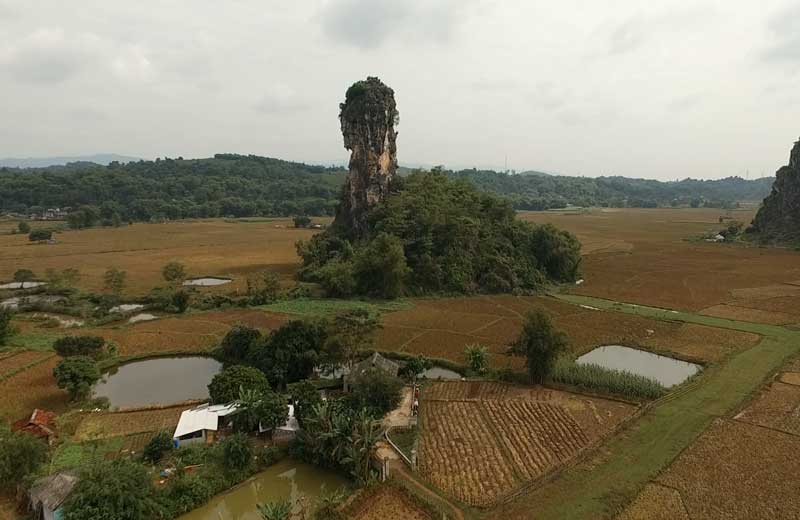
HBO – Located in Tuan Lo and Phong Phu communes, Cot Co Mountain (Khu Doi) is considered as a gift the nature offers to the area of Muong Bi in Tan Lac district. Since its appearance in the epic "De dat, de nuoc” (Giving birth to the Earth and the Water), Cot Co (Flagpole) Mountain has been a symbol in locals’ spiritual life. The mountain was officially recognised as a provincial-level landscape in November 2017, which multiplies the pride of locals and encourages people to find out Khu Doi’s legend.

Cot Co Mountain in Muong Bi area –
a cultural symbol honoured by Muong Bi locals as the most sacred mountain was
recognised as a provincial-level landscape in late 2017.
According to scientific documents stored by Hoa Binh Museum, Cot
Co (flagpole) cave is an archaeological relic belonging to the Stone Age in the
Hoa Binh Culture dating back from 30,000 to 11,000 years.
The legend has it that a feng shui master in the region, as
witnessing the poverty and difficulties facing locals, told people to find an
outstanding couple to become their leaders to expand their area.
The locals then found Tung, a man with extraordinary strength, and
his wife, a beautiful and resourceful woman, to lead them in building Muong
area. Under guidelines of the feng shui master, Tung and his wife directed
local people to build dams blocking Da River’s water, thus expanding farming
areas.
As they were building the dams, Tung, stronger and quicker, left
his wife behind when Sat, a muscular man from the nearby region went by. Enchanted
by the woman’s beauty, Sat kidnapped her and ran away. Tung chased Sat through
many mountains and hills to save his wife until he sunk into the mud and did
not able to get out. Tung desperately threw soil and rock into Sat, but in
vain. The soil and rock then became high mountains spanning Hoa Binh province
to Thanh Hoa province. After he died, Tung turned into a mountain standing in
the middle of a massive field. People called it Tung Mount (Khu Doi). Viewing
from far away, the mountain looks like a flagpole, thus locals also called it
Muong Bi Flagpole.
Boasting a mystical beauty with cultural, historical and spiritual values, Cot
Co Mountain has become an attractive tourist site. Visiting the site, tourists
can offer incense at a small temple. Those who like adventure can climb to the
top of the mountain where they enjoy the happiness of finishing an "unconquerable”
road, and seeing the scenery like a fairyland. The first thing that tourists
feel here is fresh air and the sound of mountain wind blowing through leaf
canopies. For those who cannot reach the top, visiting caves at the foot of the
mountain such as Nuoc, Cot Co Mountain (Chang Choanl), Cui and Ang Ca is also an
option../.
A diverse chain of eco-tourism and resort destinations concentrated in Hoa Binh city and the districts of Tan Lac, Da Bac, and Luong Son… Along with the launch of several key high-quality resort tourism projects, these developments have reshaped the landscape and enhanced the appeal of Hoa Binh as a travel destination.
Boasting diverse terrain, a mild climate, and rich natural resources, Cao Phong district is increasingly asserting its place on Vietnam’s tourism map, attracting both domestic and foreign visitors. The district is renowned for its stunning landscapes, majestic mountains, a crystal-clear hydropower lake, and the unique cultural identity of local ethnic groups.
With its pristine landscapes, unique cultural heritage of Muong ethnic minority, and an expanding range of visitor experiences, Tan Lac district of Hoa Binh has fast become a captivating destination for both domestic and international tourists.
Until now, Sung village in Cao Son commune, Da Bac district remains the only Dao ethnic community in Hoa Binh province to develop a community-based tourism model. Beyond its untouched natural landscapes, cultural identity serves as the cornerstone attraction for visitors.
Alongside the diverse cultural identities of the Kinh, Muong, Tay, Thai, Dao, and Mong ethnic people, Hoa Binh province is also renowned as the "capital" of the northwestern Vietnamese cuisine, offering unique and distinctive dishes. At festivals, during Lunar New Year (Tet), or on significant family or community occasions, special dishes are prepared, leaving a lasting impression on visitors.
A Phong Linh (Yellow Tabebuia) flower garden in Thang village, Thach Yen commune, Cao Phong district is currently in full bloom, drawing a large number of visitors.



